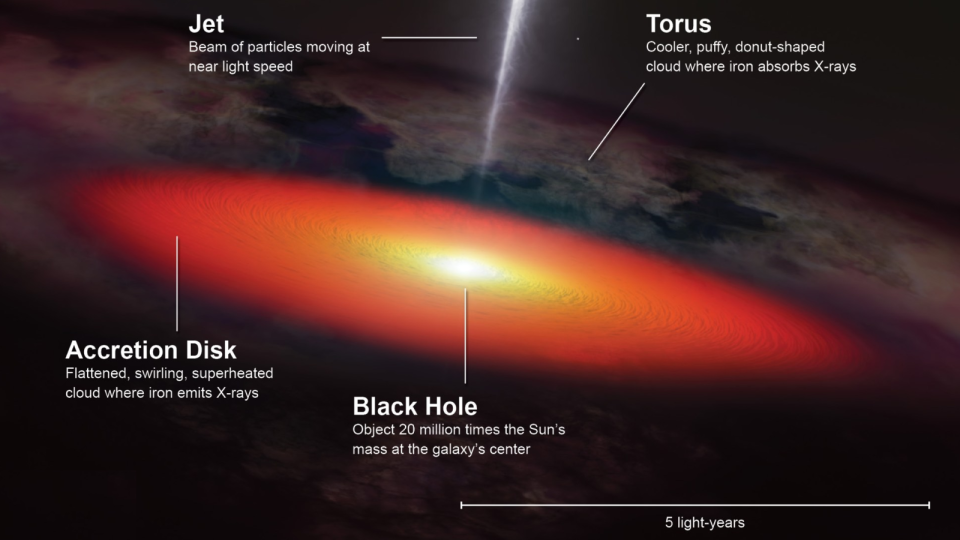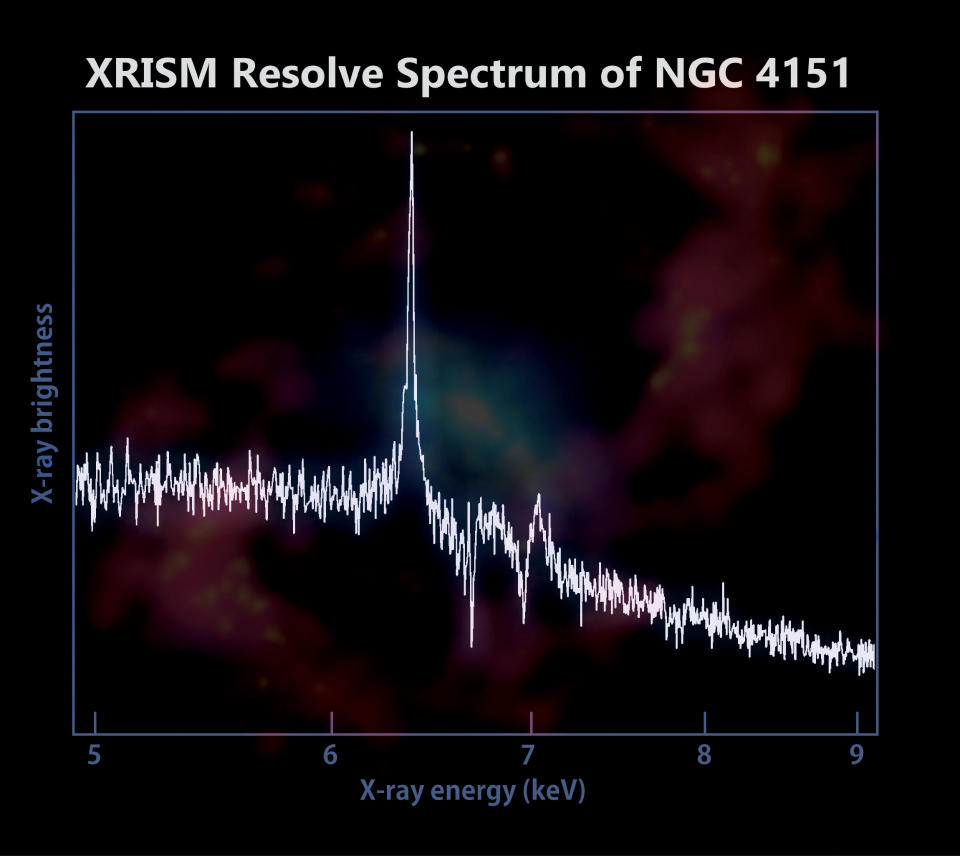Black hole week is in full swing at this point, and to celebrate, NASA has released stunning observations of the heart of a distant spiral galaxy, as well as the monster supermassive black hole that lives within that heart.
The observations were carried out by the X-ray Imaging and Spectroscopy Mission (XRISM), led by the Japan Aerospace Exploration Agency (JAXA) with contributions from NASA; They show the center of the spiral galaxy NGC 4151.
Located about 43 million light-years away, this galaxy (as well as its existing supermassive black hole, estimated to have as much mass as 20 million suns) appears in vivid reds and bright blues thanks to the addition of radio waves. This addition comes via data from the Very Large Array (VLA) and the Isaac Newton Telescope Group.
But there’s more to XRISM (pronounced “crisis”) observations than just aesthetic value. The X-ray space telescope has been able to discern fingerprints of iron in this galaxy’s Active Galactic Nucleus (AGN), which could help determine the fate of the matter orbiting its monster black hole.
Relating to: Image of the central region of spiral galaxy NGC 4151, home to a supermassive black hole
“XRISM’s Resolve instrument captured a detailed spectrum of the area around the black hole,” Brian Williams, XRISM project scientist at NASA’s Goddard Space Flight Center, said in a statement. “The peaks and valleys are like chemical fingerprints that can tell us what elements are present and provide clues about the fate of matter as we approach the black hole.”
A supermassive black hole engine
Like all AGNs, NGC 4151’s central engine shines brightly because it is powered by a supermassive black hole that actively feeds on surrounding matter.
But not all supermassive black holes are this greedy. For example, Sagittarius A* (Sgr A*), located at the heart of our galaxy, the Milky Way, has such a sparse diet that if it were a human, it would feed on a single grain of rice every 1 million years.
For an AGN, on the other hand, the gas and dust feeding the monster black hole inside forms a flattened cloud around the black hole, called an accretion disk. The black hole’s immense gravity also creates intense tidal forces on this accretion disk, heating it and causing it to glow brightly.
Additionally, matter that does not fall into the maw of the monster black hole can be channeled toward the object’s poles by strong magnetic fields that accelerate these particles to near-light speeds, blasting them into twin jets, one from each pole. This is accompanied by a burst of electromagnetic radiation that, when combined with emissions from the accretion disk, often makes an AGN brighter than the combined light of every star in the galaxy around it.

NGC 4151’s AGN is particularly bright and highly variable, even for such an active region of a galaxy. This, combined with the fact that it lies at the heart of one of the closest known active galaxies, makes NGC 4151’s black hole an ideal subject for study.
AGN has previously been studied by the Hubble Space Telescope and NASA’s Chandra X-ray Observatory to learn more about the interaction between the supermassive black hole and its surroundings. Understanding the dynamics of these two things could reveal how the growth of these cosmic giants affects the growth of the galaxies around them.
XRISM counts calories
XRISM has a distinct advantage over Hubble when it comes to examining the AGN of NGC 4151. This galaxy is unusually bright for certain X-rays that XRISM is adept at studying.
Using the Resolve instrument, which examines the universe using only 36 pixels, XRISM was able to reconstruct the spectrum of light from the AGN. Because chemical elements and compounds absorb and emit light at characteristic wavelengths, they leave “fingerprints” in these spectra. Indeed, in the Stability spectrum taken from the heart of NGC 4151, scientists were able to identify energies associated with this AGN peak just below the characteristic emission line associated with the element iron.
Scientists have theorized that the majority of the power of AGNs arises through X-rays originating from regions of hot, flaring matter embedded in the accretion disk near central black holes. When these X-rays are reflected from cooler, denser regions of the same rotating cloud of matter, they are believed to cause the iron in those regions to glow; In fact, this is the reason for this discovery.
This means that detecting iron and an X-ray peak around this supermassive black hole paints a clearer picture of the events found in such exploding disks and fragments.


The spectrum of the AGN at the heart of NGC 4151 also shows absorption lines characteristic of surrounding iron. It appears that iron is absorbed rather than emitted in these regions because they are cooler than the flared regions of the accretion disk closer to the black hole.
All this radiation is approximately 2,500 times more energetic than light in the visible region of the electromagnetic spectrum; This is the only type of light our eyes evolved to see.
RELATED STORIES:
— How do some black holes get so big? The James Webb Space Telescope may have an answer
— Brightest quasar ever seen is powered by black hole eating ‘a sun a day’
-Record holder! The Milky Way’s largest stellar-mass black hole is a sleeping giant lurking near Earth (Video)
Although this specific result from XRISM focuses on iron, this is certainly not the only element the X-ray telescope can distinguish. The satellite can also detect sulfur, calcium, argon and other elements in AGNs (as well as other celestial bodies), depending on the source.
Each of these elements can tell scientists a different side of the story of the celestial bodies they surround or even form. This makes XRISM a vital tool for the future of astronomy and the effort to decipher the X-ray sky.